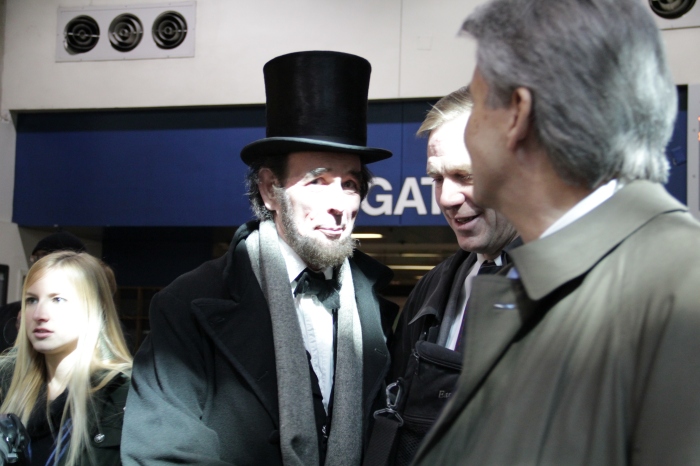I was standing in the cold on the platform of Union Station yesterday, waiting expectantly with camera in hand for the president to arrive. The 11:21 AM train had just pulled in and was emptied of people, but its most important passenger was still on board.
A small cluster of Amtrak officials and security guards stood nearby. I recognized Ken Salazar, Secretary of the Interior, as he walked by (such is the nature of our celebrities in the District). He was escorted into the train by National Park Service rangers to officially welcome the president to Washington.

Eventually I saw an entourage of police, officials, reporters, and photographers emerge from the car and walk toward me on the platform, all surrounding the District’s most important new resident. Finally, he came into view. The former senator from Illinois was taller than I expected, but I couldn’t yet see his face.
What I saw first was the top of his stovepipe hat.
Then I saw the long face, the hollow cheeks, the short beard. There was no mistaking it – Mr. Lincoln had arrived (again) in the District.
So, for those of you asking yourselves, “Did he really take an early lunch hour to document the arrival by train of a
professional Lincoln impersonator, commemorating the 150th anniversary of the 16th president’s journey to his new home of Washington, D.C.?”
The answer is yes. And I have the photographs to prove it.
Today’s event at Union Station was sponsored by the National Park Service in honor of Lincoln’s 12 day, seven state, 1,900 mile train trip from his hometown of Springfield, Illinois for his inauguration. It’s one of many events planned this year for the sesquicentennial of the beginning of the Civil War, which started in April 1861.
The real Lincoln’s journey was also a kind of public relations stunt. He stopped in 16 towns and cities along the way as part of a whistle-stop tour to introduce himself to the American public, the first member of the anti-slavery Republican Party to be elected president.
His election had caused seven states to secede from the Union and choose their own president, Jefferson Davis, who had already been inaugurated in a rival capital city.
Because of a potential assassination plot in Baltimore, Lincoln was snuck through the city in the dead of night, escorted by security guards led by Alan Pinkerton. Pinkerton was a Scottish immigrant and the nation’s first private detective, founder of the Pinkerton National Detective Agency in Chicago. (Its motto: “We Never Sleep” – I think I could have worked there…)
Pinkerton would also later become the chief of the Union Intelligence Service during the Civil War, the forerunner of today’s Secret Service, which continues to guard the president.
Lincoln arrived in the District in disguise on the early morning of February 23. With no presidential fanfare, he was quickly ushered to the famous Willard Hotel, a stone’s throw from the White House. And there he stayed until taking the oath of office on March 4 – the traditional day of inaugurations (until the Twentieth Amendment in 1933 moved it to January to avoid lame duck presidencies).
The city he had arrived in was quite changed from the one he knew as a U.S. Representative during the 1840s, and much different from the city we know today. To start with, there was no Union Station. The Washington Monument was still stuck in an unfinished state, an “ungainly old chimney” according to Mark Twain. The new Capitol dome was still under construction, and the grand avenue connecting the Capitol to the White House – Pennsylvania Avenue – was a muddy, unpaved mess.

The city was awash with Southern sympathizers and secessionists, to the point where it was sometimes an unsafe home for the new president. Lincoln had made what was considered a most ignominious arrival, and was derided in newspapers throughout the country for sneaking the last few miles into the District in disguise.
Of course, he would leave the District four years later as a martyred president, destined to become a national hero. His funeral train would make a similar journey across the nation, only in reverse, back to Springfield, Illinois.
But all that lay ahead, after four years of bloody warfare that eventually ended slavery and forever changed the nation.
Meanwhile, back in the present day, I felt like 19th Century paparazzi, or maybe Civil War photographer and District resident Mathew Brady, snapping photo after photo of the president-elect.
He showed us the contents of his carpet bag luggage – the bible he planned to use for his swearing-in, and presumably his inaugural speech was in there too.
He certainly seemed presidential, shaking hands and surprising Washingtonians as he was escorted through Union Station to a waiting bus. He was headed to Ford’s Theater to speak to a school group from Baltimore about the sacrifices of the Civil War.
Considering the history, it seemed an ironic choice of location and audiences.
The commemorations will continue on Saturday, March 5, with a recreation of Lincoln’s first inaugural address at the U.S. Capitol Visitor Center auditorium at 10 AM (and live on C-SPAN).
Tune in as Sam Waterson, of Law and Order fame, appeals to the better angels of our nature.
That’s some quality journalism! Nice pics.